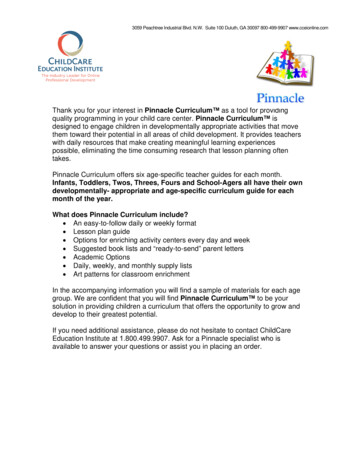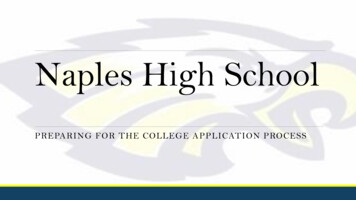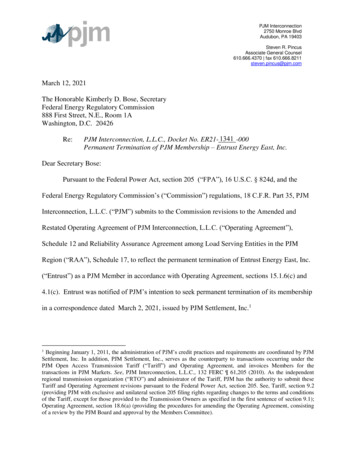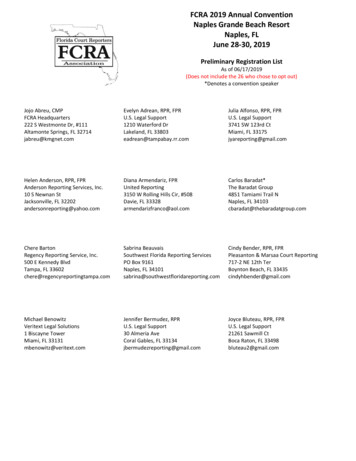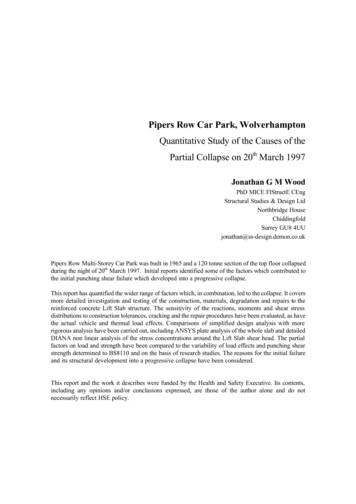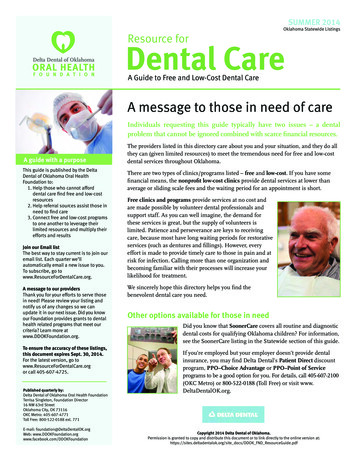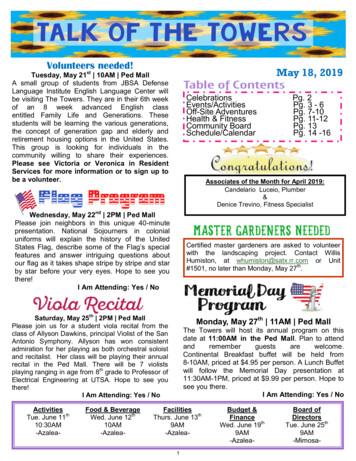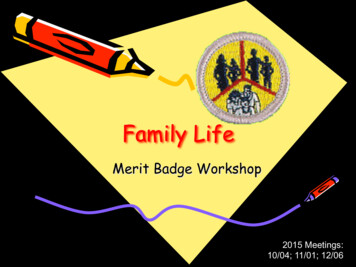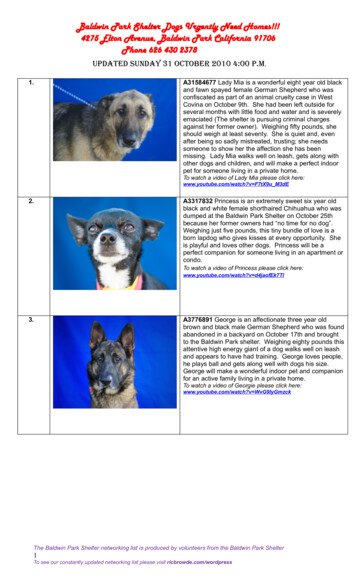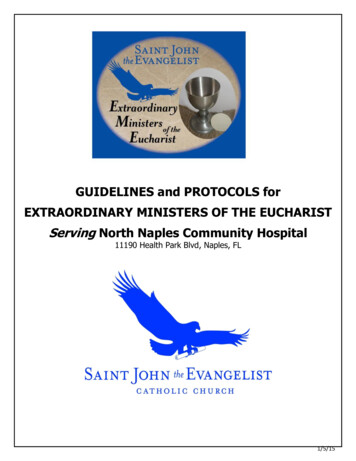
Transcription
GUIDELINES and PROTOCOLS forEXTRAORDINARY MINISTERS OF THE EUCHARISTServing North Naples Community Hospital11190 Health Park Blvd, Naples, FL1/5/15
Dear Extraordinary Ministers of the Eucharist,It is with great pleasure that I present to you the new Extraordinary Ministers of the Eucharist Handbook.This work is the fruit of much collaboration with the leaders who help organize this invaluable ministryto the People of God. Your participation is crucial and gives witness as you reach out to others with theReal Presence of the Lord. There is such a high dignity in the apostolate in which you share. I cannotthink of any greater gift than for one to take Christ and gift him to others. Those who come to our churchor those who are housebound or in nursing homes or in hospitals, witness you, a person of love andservice, giving them that greatest gift ever – Jesus.This Handbook offers a comprehensive overview to what is involved in this wonderful ministry. It offershelpful suggestions to assist you. The love and care that is shown in your ministry helps to bring us alltogether as the Body of Christ. It is my hope that all of us can work together collaboratively to make ourministry evermore fruitful.With gratitude, I assure you of my prayers and good wishes as we continue together to serve the Lord.Sincerely in Christ,Fr. John J. LuddenPastor625 111th Avenue North Naples, FL 34108 phone 239-566-8740 fax 239-566-9117www.SaintJohnTheEvangelist.com1
TABLE OF CONTENTSTABLE OF CONTENTS.2Our Mission.3Minister Preparation.3Visitation Guidelines and Procedures.3Materials needed.3Entering the Hospital.4Areas to Visit.4The Visit.5The Rite.6-7Completing your Visit.7What If.8-9Scheduling.10Summary.10Resource List.11Glossary.12-152
ADMINISTERING TO THE SICK at the HOSPITALGUIDELINES AND PROCEDURESEXTRAORDINARY MINISTERS OF THE EUCHARISTSaint John the Evangelist Catholic Church is responsible for taking the Eucharist to North NaplesCommunity Hospital (NCH) located at 11190 Health Park Blvd, Naples, FL.Our Mission: It is our mission to bring spiritual strength, healing grace and peace to our patientsthrough the power of the Eucharist. Through visitation and prayer we help our patients toexperience spirituality and faith by discovering the power of our Lord.Minister Preparation:PRAYER/MASS: As with all ministries, the most important way to prepare to serve is through prayer.How you pray is not as important as that you pray. Hospital EMEs are to attend the morning Mass atSaint John the Evangelist on their scheduled day of visitation.Quietly enter the Sacristy to obtain unconsecrated hosts from the Hospital/Homebound cabinet. Theunconsecrated hosts should be placed in a pyx which should be placed upon the altar PRIOR to thebeginning of Mass. After Mass is completed and the priest has left the altar, you may go up on thealtar, bow/genuflect before the Tabernacle and retrieve your pyx holding the Eucharist. Ideally thepyx should be carried in a burse or a case, kept on your person and kept safe. Never leave theEucharist unattended. Go directly to the hospital. Taking the Eucharist to the sick is a mostsacred duty and we need to be reverent of the Blessed Sacrament.(If you have borrowed a pyx from the Hospital/Homebound cabinet in the Sacristy, please return thepyx after your visit. The pyxides are there for use by all the Extraordinary Ministers of the Eucharist)PROPER ATTIRE: What we wear as EMEs speaks, without words, about the respect and reverencewe have for the Eucharist that we hold and carry. Appropriate attire for your hospital visit is the sameas for Mass EMEs.Visitation Guidelines and Procedures:MATERIALS NEEDED: Pyx (Burse is optional) ID badge issued by the Hospital (required), SJE name badge (optional) Communion of the Sick book Rosaries ( in the Homebound/Hospital cabinet in Sacristy) Prayer Cards (in the Homebound/Hospital cabinet in the Sacristy), optionalo “I was here today” cards for patients who are asleep or out of their room Recent SJE Bulletin (optional) “Magnificat” or “Give Us This Day” provides daily scripture Holy water (optional) Pen/pencil3
ENTERING THE HOSPITAL: Begin your visitation by going to the Brookdale Rehab & TherapyCenter. The Brookdale Center is located at the end of Health Park Blvd on the right. After enteringthe main doors of the Brookdale Center turn left and enter the Volunteer Office. Nancy is theDirector of the Volunteers. The Catholic Census will be on your right in a folder directly behind thedoor. Make a copy of the Catholic Census for yourself and return the original to its folder. PLEASECHECK TO MAKE SURE THE DATE LISTED AT THE TOP OF THE CENSUS IS THE CORRECT DATE FORTHIS VISITATION. If the door is locked, speak with the volunteer sitting at the main desk by theentrance door. The volunteer should have a key to let you into the office to obtain the census. Ifthere is no one at that desk, go to the security office which is to the right past the volunteer deskand on the left side of the hallway. You may need to have the security officer paged. If you areunable to enter the office after a period of time it will be necessary for you to leave the hospital aswe cannot visit patients without obtaining the census. Please contact the SJE Hospital MinistryCoordinator if you are unable to visit because of this situation.AREAS TO VISIT: Take the time to sit down with your document NCH NORTH - AREAS OFVISITATION and divide the census list according to the floors and room numbers mentioned. Wevisit the Brookdale Rehab & Therapy Center, The Birthing Center (2nd floor only), Emergency RoomObservation area, general hospital rooms on floors #2-6, ICU (floor#2) and Pediatrics (floor#3).(WE WILL NOT BE SERVING COMMUNION TO PATIENTS IN THE EMERGENCY ROOM.)Brookdale is a unique unit. Most of the patients have a very busy rehab schedule. You will find manypatients are out of their rooms when you visit this unit. You can leave our “I was here ” card or youcan ask the secretary for their schedule to find out what where they are. Often it is difficult to enterand disrupt the therapy session to give Communion. Again use your good judgment. The BirthingCenter is a happy place! Most mothers have their doors closed and really do not want to bedisturbed.again if the door is completely closed please do not disturb them. The Emergency Roomunit is also locked. We should NOT visit patients in the Emergency Room or the Observation area.The ICU is also a special, locked unit. It is VERY important that you talk with the nurses (along withthe unit secretary) caring for the patients before you enter their room. Pediatrics is another lockedunit. Before going into the room, ask the secretary the age of the patient along with the otherinformation that you need to know. In the pediatric unit, Communion is often given to the parents ofthe patient rather than the patient.Every floor and every specialty unit has a Unit Secretary. It is very important and required by thehospital that you stop and introduce yourself to the secretary and then proceed to recite to thesecretary the list of Catholic patients on the census. Room number and last name of the patient is tobe given to the secretary in order to make sure the correct patient is in the stated room. Thesecretary is to review each patient as to whether they are able to receive Communion.It is strongly requested by the NCH Infection Control Department that you do not enter isolationrooms. This is for YOUR protection as well as for the protection of the patient. Communion is NOT tobe given to patients that are fasting indicated by NPO (nothing by mouth), as well as patients thatare in isolation rooms and patients with tubes in their mouth or nose.Please note: Many of the secretaries ask you to check the screens outside the patient’s door beforeentering the room. Please insist that they check their list as the screens do not always have up todate information nor do they give particular information like gluten intolerance, difficulty withswallowing and various other medical reasons as to why the patient should not receive Communion.4
THE VISIT: When visiting your patients please be aware of their privacy. Confidentiality iscrucial. Do not make other patients, fellow parishioners, friends and other visitors aware of apatient’s situation.Keep in mind that you should not enter a room if the door is completely closed and/or if the curtain isclosed and also refrain from entering when a doctor or nurse is with the patient. Visit other patientson the floor and then go back to the rooms that you were not able to enter to see if the situation haschanged. Please do not enter a room without knocking to let them know you are entering.Sanitize your hands with the antibacterial lotion located in each room upon entering and leaving theroom. (Hand sanitizing lotion is readily available so take advantage of using it frequently for yourprotection and for those you are visiting.)Introduce yourself using your name, your “title” of Extraordinary Minister of the Eucharist and thename of our church and ask the patient if he/she would like to receive Communion. It is a goodpractice to ask if the patient is Catholic. To satisfy hospital regulations, ask the patient to give youtheir name to verify their identity if possible or you can check their hospital ID band on their wrist.Communicate with the patients, stay with them, talk to them to create a friendly acceptingatmosphere. Ask that they mute or minimize the volume on the TV during the visit.The decision to receive or not to receive the Eucharist is to be made by the patient. No one is to betold that they should or should not receive Communion. If a patient does not want Communion andwould rather not be bothered, leave the room with a pleasant attitude and you may say “God BlessYou”. Some patients will want prayers only. In whatever setting you find yourself visiting yourpatients, be mindful of the importance of praying with the person who is ill. Do not be afraid to askthe patient if they would like to pray. The Holy Spirit will guide you!Recognize the needs of the patients who would like a short visit. Be sensitive to the proper time todepart. If the patient appears to be in discomfort, sleepy or unaware of surroundings make the visitshort and discern whether this is the right time to give Holy Communion perhaps say a prayerinstead. If the person cannot receive but is in need of a visit you can say prayers and make the signof the cross on their forehead with your thumb with or without Holy water and say “May the Lord’spresence bring you comfort and peace”.If the patient can receive Communion, at the minimum, the Lord’s Prayer and the Lambof God should always be said before receiving Communion.If your patient does want Communion and there are others visiting the patient, invite them toparticipate in the prayers and ask Catholic visitors if they would like to receive Communion. You maybreak the Hosts in half if there are other communicants in the room beside the patient.Be sure to leave our SJE prayer card and ask if the patient would like a rosary. If the patient isasleep or out of the room, leave the “I was here today ” card on the bedside table with your firstname and date. It is very important that they know you were there and they were not overlooked.Provide the NCH Pastoral Care Department with the following requested information, mark thecensus list with “V” for visited, “P” for prayers, “C” for Communion given and “card” for the “I washere today” card. Also, please write your name at the bottom of each page of the census.5
THE RITE:Begin with the Sign of the Cross. It is a common call to prayer. See the book “Communion of theSick” which provides the rites, prayers, reading and intercessions that can be used and adapted asappropriate. This book is to be used as a guide. We, as hospital Extraordinary Ministers of theEucharist, should follow:The Ordinary Rite of Communion of the Sick (Communion in Ordinary Circumstances): This Rite issimply outlined in the book “Communion of the Sick”. This narrative serves as a synopsis of the Rite.It is best that you carry the book with you on your visits; however the Lord’s Prayer, the Lamb ofGod and Communion should be carried out without referring to the book at that time.Legend: A: Action R: ReciteINTRODUCTORY RITEGreetingA: Make the Sign of the Cross with or without the sprinkling of Holy waterR: “The peace of the Lord be with you.”Penitential Act: (recite C)R: “By your Paschal Mystery, you have won for us salvation; Lord have mercy. May almighty Godhave mercy on us, forgive us our sins, and bring us to everlasting life. AMEN”LITURGY OF THE WORDA: Reading of the Word: Gospel of the day or readings listed in the bookA: Response: Brief silence and brief discussion of the readingA: Universal prayer – You may ask the patient to state their intentions so that you can pray forthem; using the various Universal prayers on page 39 of your book or you can read the SJE “Patient’sPrayer” to them.LITURGY OF HOLY COMMUNIONThe Lord’s PrayerR: The Lord’s Prayer (ALWAYS recited with the patient before Communion) while holding ortouching their hand, if they are accepting of this.A: Take the Host out of the pyx and hold the Blessed Sacrament up to show all who are inattendance. Continue to hold the Host up as you say:Lamb of GodR: This is Jesus, Behold the Lamb of God; behold him who takes away the sins of the world.Blessed are those called to the supper of the Lamb. (ALWAYS said before Communion)CommunionA: All who are to receive Communion need to recite:R: Lord, I am not worthy that you should enter under my roof, but only say the word and my soulshall be healed”.A: We approach the patient showing the Blessed Sacrament and say:R: “The Body of Christ”.A: The patient receives. The minister places the Host in the palm of their hand or on their tongue.A: If there are others in the room, we serve each one showing the Blessed Sacrament and say:R: “The Body of Christ”. They receive. The minister places the Host in the palm of their hand oron their tongue. (Please watch to ensure they have consumed the Host.)6
Silent PrayerThere should be a time for silent prayer. Wait for the patient to acknowledge to you that they havecompleted their prayers and are ready to continue with your visit. If they continue to pray for a longperiod of time, use your judgment as to whether you should touch them gently to let them know youare still there. Perhaps it is time to just say, “God bless you” and leave quietly.You can also say a prayer from the many listed in the book on pages 18-20.Prayer after Communion (optional)CONCLUDING RITEBlessingMake the sign of the Cross on yourself and recite either A or B on page 21 or recite your ownblessing. You can use the Holy Water at this time by making the Cross with your thumb over theirforehead.COMPLETING YOUR VISITS: After completing your visits, if you have time, you may want tobacktrack to visit the patients that you missed. When finished go to the hospital chapel which islocated on the first floor of the hospital by the main elevators. The chaplain’s office is in the back.The top desk drawer on the left is the SJE drawer. You will find a blue notebook containing the” EMENCH Communion Log” Please place the date of the visit, your name, the number of patients visited,the number of patients that received Communion and additional Communion given to medicalpersonnel and the patient’s visitors/family members who are Catholic. This information will be talliedquarterly and submitted to Fr. John.Before leaving the chapel, say a prayer for the patients that you visited and prepare to consume theremaining Hosts by saying The Our Father. The pyx with the Hosts should not be kept overnight inyour home or other place. It is often difficult to decide the number of Hosts we should take to thehospital. Normally, in season it is best to have at least 15-20 and during the summer months it isbest to have 8-10. Remember they can be broken in half and quarters if necessary.Once you have left the chapel, enter the Admitting office via the 28241 door code. You areresponsible for faxing the census to the Pastoral Care Department, NCH (downtown). Please do notask anyone else to do this for you. The fax number is 9-624-2601. Once confirmation of receipt hasbeen received (via the fax machine) place the census in the shredding container. It is illegal to takethe census off hospital property.7
WHAT IF The person who is ill says they need to go to confession before they receive Communion:Extraordinary Ministers of the Eucharist do not hear confessions. This Sacrament is only to beadministered by an ordained priest. If the patient does ask to see a priest, contact the parish officeat 566-8740 and leave their name and hospital room number.The person who is ill or a member of the family request they receive the Sacrament ofthe Anointing of the Sick: Only a priest can administer the Sacrament of the Anointing of theSick.You receive a request to visit and give Communion to a dying patient: As an ExtraordinaryMinister of the Eucharist you may be called upon to give Communion to a dying patient IF the patientis able to physically take the Host. Perhaps this will be the last time the patient receives Communionin this life. This is called Viaticum. If the patient is unable to take Communion, pray and bless thepatient with Holy Water or hold a Host over the patient and make the sign of the Cross with the Host.Then place the Host back in the pyx. Ideally, a priest will be called to perform the Viaticum but thereare rare circumstances where you may be called upon to be there for the patient and family. Makesure to ask the Catholic family members if they would like to receive Communion.Non-Catholics request to receive: Generally, they should not receive. You can offer to pray withthe person and give a blessing to them by making the Sign of the Cross on their forehead. This is notthe same as the blessing that only an ordained priest or deacon could give.The sick person cannot consume the Host and spits it out: Use toweling, Kleenex or ahandkerchief to pick up the piece of Host and securely wrap it then take it with you until you finishyour visitations. NEVER CONSUME THIS HOST. Bury the Host in the ground.The person cannot consume a whole Host: You may always break the Host into
visit the Brookdale Rehab & Therapy Center, The Birthing Center (2nd floor only), Emergency Room Observation area, general hospital rooms on floors #2-6, ICU (floor#2) and Pediatrics (floor#3). (WE WILL NOT BE SERVING COMMUNION TO PATIENTS IN THE EMERGENCY ROOM.) Brookdale is a unique unit. Most of the p
